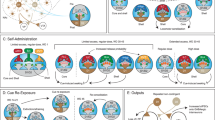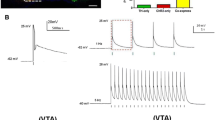Abstract
The subthalamic nucleus (STN) is a key node in cortico-basal-ganglia thalamic circuits, guiding behavioral output through its position as an excitatory relay of the striatal indirect pathway and its direct connections with the cortex. There have been conflicting results regarding the role of the STN in addiction-related behavior to psychostimulants, and little is known with respect to the role of STN afferents. To address this, we used viral vectors to express DREADDs (Designer Receptors Exclusively Activated by Designer Drugs) in the STN of rats in order to bidirectionally manipulate STN activity during the induction of amphetamine sensitization. In addition, we used a Cre-recombinase dependent Gi/o-coupled DREADD approach to transiently inhibit afferents from ventral pallidum (a subcomponent of the striatal indirect pathway) or the prelimbic cortex (a subcomponent of the cortico-STN hyperdirect pathway). Despite inducing mild hyperactivity in non-drug controls, stimulation of STN neurons with Gq-DREADDs blocked the development and persistence of amphetamine sensitization as well as conditioned responding. In contrast, inhibition of STN neurons with Gi/o-DREADDs enhanced the induction of sensitization without altering its persistence or conditioned responding. Chemogenetic inhibition of afferents from ventral pallidum had no effect on amphetamine sensitization but blocked conditioned responding whereas chemogenetic inhibition of afferents from prelimbic cortex attenuated the persistence of sensitization as well as conditioned responding. These results suggest the STN and its afferents play complex roles in the regulation of amphetamine sensitization and highlight the need for further characterization of how integration of inputs within STN guide behavior.




Similar content being viewed by others
References
Alkemade A (2013) Subdivisions and anatomical boundaries of the subthalamic nucleus. J Neurosci 33:9233–9234
Allain F, Samaha AN (2019) Revisiting long-access versus short-access cocaine self-administration in rats: intermittent intake promotes addiction symptoms independent of length. Addict Biol 24:641–651
Anagnostaras SG, Robinson TE (1996) Sensitization to the psychomotor stimulant effects of amphetamine: modulation by associative learning. Behav Neurosci 110:1397–1414
Andrén PE, Levin ED, Liminga U, Gunne L (1995) Behavioral and neurochemical consequences of ibotenic acid lesion in the subthalamic nucleus of the common marmoset. Brain Res Bull 36:301–307
Armbruster BN, Li X, Pausch MH, Herlitze S, Roth BL (2007) Evolving the lock to fit the key to create a family of G protein-coupled receptors potently activated by an inert ligand. Proc Natl Acad Sci 104:5163–5168
Baunez C, Dias C, Cador M, Amalric M (2005) The subthalamic nucleus exerts opposite control on cocaine and “natural” rewards. Nat Neurosci 8:484–489
Bentzley BS, Aston-Jones G (2016) Inhibiting subthalamic nucleus decreases cocaine demand and relapse: therapeutic potential. Addict Biol
Berke JD, Hyman SE (2000) Addiction, dopamine, and the molecular mechanisms of memory. Neuron 25:515–532
Bosch C, Mailly P, Degos B, Deniau JM, Venance L (2012) Preservation of the hyperdirect pathway of basal ganglia in a rodent brain slice. Neuroscience 215:31–41
Burnett CJ, Krashes MJ (2016) Resolving behavioral output via chemogenetic designer receptors exclusively activated by designer drugs. J Neurosci 36:9268–9282
Canteras NS, Shammah-Lagnado SJ, Silva BA, Ricardo JA (1990) Afferent connections of the subthalamic nucleus: a combined retrograde and anterograde horseradish peroxidase study in the rat. Brain Res
Castro-Alamancos MA, Borrel J (1995) Functional recovery of forelimb response capacity after forelimb primary motor cortex damage in the rat is due to the reorganization of adjacent areas of cortex. Neuroscience 68:793–805
Chu H-Y, Atherton JF, Wokosin D, Surmeier DJ, Bevan MD (2015) Heterosynaptic regulation of external globus pallidus inputs to the subthalamic nucleus by the motor cortex. Neuron 85:364–376
Delfs JM, Ciaramitaro VM, Parry TJ, Chesselet MF (1995) Subthalamic nucleus lesions: widespread effects on changes in gene expression induced by nigrostriatal dopamine depletion in rats. J Neurosci 15:6562–6575
Ferguson SM, Neumaier JF (2012) Grateful DREADDs: engineered receptors reveal how neural circuits regulate behavior. Neuropsychopharmacology 37:296–297
Ferguson SM, Eskenazi D, Ishikawa M, Wanat MJ, Phillips PEM, Dong Y, Roth BL, Neumaier JF (2011) Transient neuronal inhibition reveals opposing roles of indirect and direct pathways in sensitization. Nat Neurosci 14:22–24
Ferguson SM, Phillips PEM, Roth BL, Wess J, Neumaier JF (2013) Direct-pathway striatal neurons regulate the retention of decision-making strategies. J Neurosci 33:11668–11676
Garcia AF, Webb IG, Yager LM, Seo MB, Ferguson SM (2020) Intermittent but not continuous access to cocaine produces individual variability in addiction susceptibility in rats. Psychopharmacology 237:2929–2941
Groenewegen HJ, Berendse HW (1990) Connections of the subthalamic nucleus with ventral striatopallidal parts of the basal ganglia in the rat. J Comp Neurol 294:607–622
Haynes WIA, Haber SN (2013) The organization of prefrontal-subthalamic inputs in primates provides an anatomical substrate for both functional specificity and integration: implications for Basal Ganglia models and deep brain stimulation. J Neurosci 33:4804–4814
Kantak KM, Yager LM, Brisotti MF (2013) Impact of medial orbital cortex and medial subthalamic nucleus inactivation, individually and together, on the maintenance of cocaine self-administration behavior in rats. Behav Brain Res 238:1–9
Kerstetter KA, Wunsch AM, Nakata KG, Donckels E, Neumaier JF, Ferguson SM (2015) Corticostriatal afferents modulate responsiveness to psychostimulant drugs and drug-associated stimuli. Neuropsychopharmacology
Kita H, Kitai ST (1987) Efferent projections of the subthalamic nucleus in the rat: light and electron microscopic analysis with the PHA-L method. J Comp Neurol 260:435–452
Kita T, Osten P, Kita H (2014) Rat subthalamic nucleus and zona incerta share extensively overlapped representations of cortical functional territories. J Comp Neurol 522:4043–4056
Koob GF, Volkow ND (2016) Neurobiology of addiction: a neurocircuitry analysis. Lancet Psychiatry 3:760–773
Kremer EJ, Boutin S, Chillon M, Danos O (2000) Canine adenovirus vectors: an alternative for adenovirus-mediated gene transfer. J Virol 74:505–512
Lévesque J-C, Parent A (2005) GABAergic interneurons in human subthalamic nucleus. Mov Disord 20:574–584
Lobo MK, Nestler EJ (2011) The striatal balancing act in drug addiction: distinct roles of direct and indirect pathway medium spiny neurons. Front Neuroanat 5:41
Luigjes J, van den Brink W, Feenstra M, van den Munckhof P, Schuurman PR, Schippers R, Mazaheri A, De Vries TJ, Denys D (2012) Deep brain stimulation in addiction: a review of potential brain targets. Mol Psychiatry 17:572–583
Lüscher C, Malenka RC (2011) Drug-evoked synaptic plasticity in addiction: from molecular changes to circuit remodeling. Neuron 69:650–663
Nambu A, Takada M, Inase M, Tokuno H (1996) Dual somatotopical representations in the primate subthalamic nucleus: evidence for ordered but reversed body-map transformations from the primary motor cortex and the supplementary motor area. J Neurosci 16:2671–2683
Nestler EJ (2001) Molecular basis of long-term plasticity underlying addiction. Nat Rev Neurosci 2:119–128
Paulson PE, Robinson TE (1991) Sensitization to systemic amphetamine produces an enhanced locomotor response to a subsequent intra-accumbens amphetamine challenge in rats. Psychopharmacology 104:140–141
Pelloux Y, Baunez C (2013) Deep brain stimulation for addiction: why the subthalamic nucleus should be favored. Curr Opin Neurobiol 23:713–720
Pelloux Y, Baunez C (2017) Targeting the subthalamic nucleus in a preclinical model of alcohol use disorder. Psychopharmacology 234:2127–2137
Pelloux Y, Degoulet M, Tiran-Cappello A, Cohen C, Lardeux S, George O, Koob GF, Ahmed SH, Baunez C (2018) Subthalamic nucleus high frequency stimulation prevents and reverses escalated cocaine use. Mol Psychiatry 23:2266–2276
Pierce RC, Vassoler FM (2013) Deep brain stimulation for the treatment of addiction: basic and clinical studies and potential mechanisms of action. Psychopharmacology 229:487–491
Prasad AA, McNally GP (2016) Ventral pallidum output pathways in context-induced reinstatement of alcohol seeking. J Neurosci 36:11716–11726
Robinson TE, Becker JB (1986) Enduring changes in brain and behavior produced by chronic amphetamine administration: a review and evaluation of animal models of amphetamine psychosis. Brain Res 396:157–198
Robinson TE, Berridge KC (2000) The psychology and neurobiology of addiction: an incentive-sensitization view. Addiction 95(Suppl 2):S91-117
Robinson TE, Berridge KC (2008) Review. The incentive sensitization theory of addiction: some current issues. Philos. Trans. R. Soc. Lond., B. Biol Sci 363:3137–3146
Romansky KV, Usunoff KG, Ivanov DP, Galabov GP (1979) Corticosubthalamic projection in the cat: an electron microscopic study. Brain Res 163:319–322
Roth BL (2016) DREADDs for neuroscientists. Neuron 89:683–694
Rouaud T, Lardeux S, Panayotis N, Paleressompoulle D, Cador M, Baunez C (2010) Reducing the desire for cocaine with subthalamic nucleus deep brain stimulation. Proc Natl Acad Sci USA 107:1196–1200
Segal DS, Mandell AJ (1974) Long-term administration of d-amphetamine: progressive augmentation of motor activity and stereotypy. Pharmacol Biochem Behav 2:249–255
Smith KS, Bucci DJ, Luikart BW, Mahler SV (2016) DREADDS: use and application in behavioral neuroscience. Behav Neurosci 130:137–155
Temel Y, Blokland A, Steinbusch HWM, Visser-Vandewalle V (2005) The functional role of the subthalamic nucleus in cognitive and limbic circuits. Prog Neurobiol 76:393–413
Uslaner JM, Yang P, Robinson TE (2005) Subthalamic nucleus lesions enhance the psychomotor-activating, incentive motivational, and neurobiological effects of cocaine. J Neurosci 25:8407–8415
Wade CL, Kallupi M, Hernandez DO, Breysse E, de Guglielmo G, Crawford E, Koob GF, Schweitzer P, Baunez C, George O (2017) High-frequency stimulation of the subthalamic nucleus blocks compulsive-like re-escalation of heroin taking in rats. Neuropsychopharmacology 42:1850–1859
Wall NR, Parra La, De M, Callaway EM, Kreitzer AC (2013) Differential innervation of direct- and indirect-pathway striatal projection neurons. Neuron 79:347–360
Wise RA, Bozarth MA (1987) A psychomotor stimulant theory of addiction. Psychol Rev 94:469–492
Wunsch AM, Yager LM, Donckels EA, Le CT, Neumaier JF, Ferguson SM (2017) Chemogenetic inhibition reveals midline thalamic nuclei and thalamo-accumbens projections mediate cocaine-seeking in rats. Eur J Neurosci 46:1850–1862
Yager LM, Garcia AF, Wunsch AM, Ferguson SM (2015) The ins and outs of the striatum: role in drug addiction. Neuroscience 301:529–541
Yager LM, Garcia AF, Donckels EA, Ferguson SM (2019) Chemogenetic inhibition of direct pathway striatal neurons normalizes pathological, cue-induced reinstatement of drug-seeking in rats. Addict Biol 24:251–264
Acknowledgements
We thank Dr. John Neumaier and Dr. Michelle Kelly for providing the CAV2-Cre virus.
Funding
This work was supported by grants from the National Institute on Drug Abuse (R01DA036582 and R01DA036582-S1 to SMF).
Author information
Authors and Affiliations
Contributions
KGN, EY, and ES performed the behavioral and immunohistochemical experiments. KGN and SMF designed the experiments and wrote the manuscript.
Corresponding author
Ethics declarations
Conflict of interest
The authors declare no competing interests.
Additional information
Publisher's note
Springer Nature remains neutral with regard to jurisdictional claims in published maps and institutional affiliations.
Rights and permissions
About this article
Cite this article
Nakata, K.G., Yin, E., Sutlief, E. et al. Chemogenetic modulation reveals distinct roles of the subthalamic nucleus and its afferents in the regulation of locomotor sensitization to amphetamine in rats. Psychopharmacology 239, 353–364 (2022). https://doi.org/10.1007/s00213-021-05985-7
Received:
Accepted:
Published:
Issue Date:
DOI: https://doi.org/10.1007/s00213-021-05985-7




